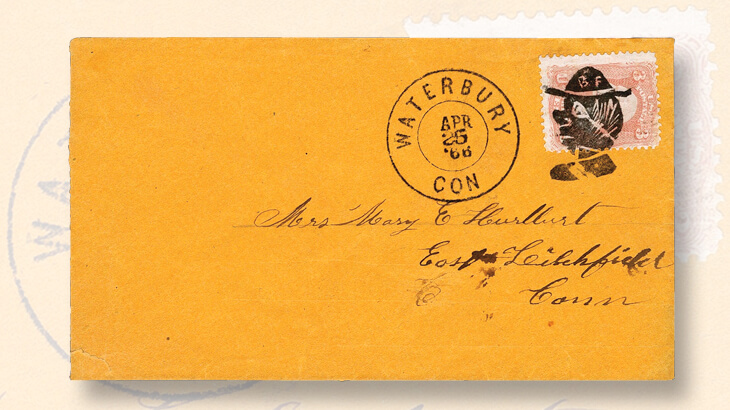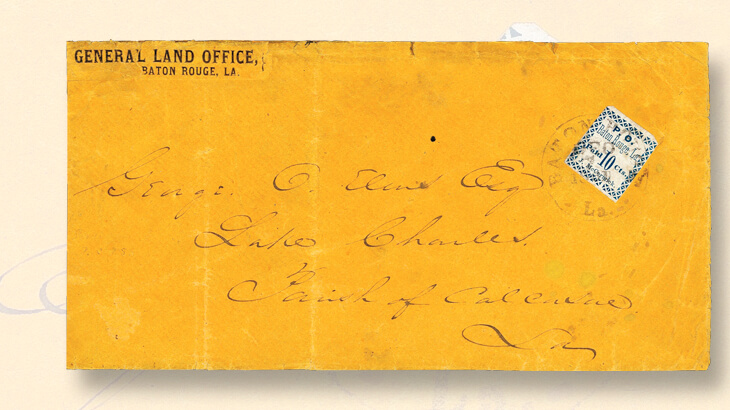Auctions
German retail magnate’s collection dominates H.R. Harmer’s U.S. auction at WSS-NY 2016
By Matthew Healey, New York Correspondent
They came, they saw, they raised their paddles.
For the tens of thousands of visitors attending World Stamp Show-NY 2016, a remarkable string of auctions by five different firms over six days brought excitement and opportunity during late May and early June.
Robert A. Siegel Auction Galleries kicked off the action on Sunday, May 29, with a pair of big-name sales: the William H. Gross collection of Hawaii, and the second part of the Steven Walske collection of trans-Atlantic mail between the United States and France.
Christoph Gaertner, of Germany, picked up the gavel on Monday, May 30, with a day-long session devoted to worldwide rarities that included an impressive selection of U.S. and Confederate postmasters’ provisionals.
Siegel resumed on Tuesday, May 31, with a record-breaking sale of the highest-graded example of the iconic American airmail rarity, the Inverted Jenny, followed by other U.S. rarities.
Wednesday, June 1, saw Schuyler Rumsey celebrate his firm’s 20th anniversary with a sale of U.S. and worldwide rarities, including U.S. Official issues collected by Robert L. Markovits, while Thursday saw the Daniel F. Kelleher firm’s offering of the Alfred J. Capurro collection of worldwide, mostly mint stamps.
H.R. Harmer, a member of the Global Philatelic Network, wrapped things up on Friday, June 3, with the award-winning Erivan Haub collection of U.S. and Confederate postmasters’ provisionals, among many other items.
Linn's Stamp News is breaking them all down in a multi-part U.S. Auction Roundup series:
Robert A. Siegel, Part I, May 29 | Christoph Gaertner, May 30 | Robert A. Siegel, Part II, May 31 | Schuyler Rumsey, June 1
H.R. Harmer, based in Tustin, Calif., offered U.S. and worldwide rarities in a morning session and the collection of retired German retail magnate Erivan Haub in the afternoon. The sales were previewed in Linn’s on May 30.
A rare March 1862 cover bearing a Confederate postmaster’s provisional stamp of Marion, Va., (Scott 55X2) was said to be one of just six examples in private hands and one of the finest overall. It sold for $60,000, including H.R. Harmer’s 20 percent buyer’s premium.
The award-winning exhibit by Don David Price of the 1979 $1 Rush Lamp and Candle Holder stamp (Scott 1610), including the invert error (1610c) known as the “C.I.A. invert” because of its discovery at that agency’s offices, fetched $60,000.
Connect with Linn’s Stamp News:
Sign up for our newsletter
Like us on Facebook
Follow us on Twitter
The Haub collection was strong in several areas of attractive and popular U.S. postal history, including fancy cancels of Waterbury, Conn., and Wells Fargo Pony Express covers.
In the 19th century, the custom for postmarking a letter was to apply a dated town cancel to a blank area of an envelope, and use some other canceling device to obliterate the postage stamp. It was left up to individual postmasters to make their own cancelers, and some got creative by carving fancy designs into pieces of cork.
One of the most famous practitioners of the cancel-carver’s art was John W. Hill, who started out in 1865 as a clerk in the Waterbury, Conn., post office and eventually moved up to postmaster before retiring in 1890. His highly collectible cancels include images of animals, insects, people, geometric designs and more; his most famous may be the Running Chicken — or is it a turkey?
Because cork is not a durable substance, most designs wore out quickly and were in use for only a short time.
A cover bearing a crisp strike of one of Hill’s best-loved designs, known as the Bridgeport Fireman, was the high seller in the Haub sale. Said to be the earliest and finest example of this fancy cancel, the cover opened at $15,000 and climbed steadily before being hammered down at $85,000 — or $102,000 with premium. The room burst into applause.
The sale included a run of impressive Pony Express covers, such as one sent from San Francisco to St Joseph, Mo., on June 22, 1861, arriving on July 4.
Bearing a red $2 Pony Express stamp (Scott 143L1) on a U.S. “star die” 10¢ stamped envelope (U33), it sold for $45,000.
The only known cover bearing a Baton Rouge, La., 10¢ postmaster’s provisional (Scott 11X4), an orange legal-size envelope sent from the General Land Office to a lawyer in Lake Charles, was another highlight of the sale: It brought $60,000.
After you finish the U.S. Auction Roundup, check out our International Auction Roundup:
Christoph Gaertner’s WSS-NY 2016 auction totals $5.74 million
Kelleher’s WSS-NY 2016 sale topped by high-denomination World War I-era overprint
H.R. Harmer sells first piece of mail from the first German expedition to Antarctica
MORE RELATED ARTICLES
Headlines
-
US Stamps
Oct 7, 2024, 3 PMMcMurtrie dismissed as APS education director following Sept. 21 arrest
-
US Stamps
Oct 7, 2024, 12 PMVasiliauskas named president of Mystic Stamp Co.
-
US Stamps
Oct 6, 2024, 5 PMApgar souvenir card available
-
US Stamps
Oct 6, 2024, 4 PMFirst Continental Congress and U.N. stamps receive Scott catalog numbers







